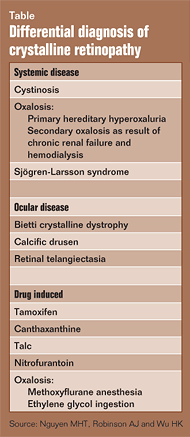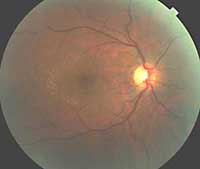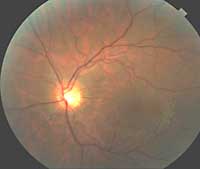Incidental finding seen in man with no ocular history
Dilated fundus exam found tiny, glistening, yellow refractile bodies in a ring-shape pattern in the posterior pole of both eyes.

A 32-year-old man presented to the New England Eye Center for his first eye exam. He had recently enrolled in a new insurance plan at work that included routine eye exams. He reported no ocular complaints.
History
 Shazia Ahmed |  My Hanh T. Nguyen |
His ocular and medical histories were unremarkable. He denied taking any medications other than a multivitamin. He had no known allergies. His family history was noncontributory. He was a pharmacist, denied smoking, consumed alcohol socially and denied IV drug abuse.
Clinical findings
On ophthalmic examination, his visual acuity without correction was 20/20 in both eyes. His IOP, pupil reactivity, extraocular muscle movements and visual fields to confrontation were all normal. His external exam was normal. Anterior segment examination was unremarkable in both eyes. Dilated fundus examination revealed tiny, glistening, yellow refractile bodies, arranged symmetrically, in a doughnut- or ring-shape pattern in the posterior pole of both eyes (Figures 1a and 1b).
|
Images: Nguyen MHT, Robinson AJ and Wu HK |

What is your diagnosis?
Incidental finding
Causes of crystalline retinopathy can be categorized by systemic disease, ocular disease and drug-induced conditions (Table). Patients with cystinosis and oxalosis often have renal abnormalities. Sjögren-Larsson syndrome is an autosomal recessive neurocutaneous disorder with extremely dry skin, spastic paralysis and mental retardation. Bietti crystalline corneoretinal dystrophy is a rare, autosomal recessive, primary choroidal atrophy affecting visual function, with retinal and corneal deposits. Calcified drusen and Coats’ disease are also on the differential diagnosis for crystalline retinopathy.
Our patient did not have any of these findings. Looking at the drug-induced causes of crystalline retinopathy, our patient was not on tamoxifen, denied IV drug abuse and was not taking nitrofurantoin, an antibiotic used for urinary tract infections. He had not been under general anesthesia and denied antifreeze consumption.
The patient was then specifically asked whether he was taking any oral tanning pills, many of which contain canthaxanthine. He admitted to taking daily bronzing pills for the past several years. The patient was diagnosed with canthaxanthine retinopathy.
Discussion

Canthaxanthine is a trans-carotenoid pigment, a derivative of beta carotene that is found in crustaceans, plants, mushrooms, bacteria, fish, algae and bird feathers. It has been used as a therapeutic agent for photosensitivity disorders, a food- and drug-coloring agent, and an oral sun-tanning agent.
As a food-coloring agent, also called orange 8, carophyll red and roxanthin red 10, it is used to enhance the color of numerous items, including pizza, barbeque and spaghetti sauces, soups, salad dressings, fruit drinks, cheeses and ketchup. On average, we consume approximately 5.6 mg of canthaxanthine daily from these coloring agents.
Canthaxanthine has been used as an oral tanning agent since 1979. It is an over-the-counter supplement available in health food stores. Canthaxanthine accumulates in skin epidermis and subcutaneous fatty tissue. It takes about 2 weeks to achieve a tan. Upon cessation of the supplement, the tan fades in about 2 weeks.
In addition to the skin, canthaxanthine is also deposited in the liver, retina and plasma. Side effects include allergic skin reactions, discoloration of stool, palms and soles of feet, gastrointestinal discomfort, hepatitis and one reported case of aplastic anemia.
Deposition of canthaxanthine in the retina is also called gold dust retinopathy. Patients are generally asymptomatic because the deposits do not involve the fovea. The deposits are tiny, glistening, yellow, refractile deposits arranged in a donut- or ring-shape pattern in the posterior pole of both eyes. Each particle is approximately 4 µm to 30 µm in size. Microscopic studies have shown that these crystals are deposited in the inner layers of the retina, from the internal limiting membrane to the inner nuclear layer. One case report using ultrahigh-resolution optical coherence tomography revealed the presence of a canthaxanthine crystal in the outer plexiform layer.
Case studies
A case report demonstrates that on red-free photographs, the crystals are more numerous and pronounced, and on fluorescein angiography there is a ring of hypofluorescence due to obstruction of the background fluorescence by the crystalline deposits.
Canthaxanthine retinopathy occurs with high doses and prolonged use. Crystalline deposits are common in patients taking more than 30 mg of canthaxanthine daily. In one study, deposits were found in 50% of patients with cumulative intake of at least 37 g and 100% of those with cumulative intake of at least 60 g.
The dosing for a canthaxanthine- containing oral tanning agent is based on the patient’s weight. In general, the first 4 weeks is the saturation period during which an extremely high amount is consumed. Once a golden/bronze tan is achieved, the dosage is cut approximately by half. Based on the typical recommended dosing regimen, an average 150-lb patient would reach a cumulative intake of 37 g in less than 2 years and 60 g in 3 years.
Despite these deposits, the retina function is usually normal. However, there are case studies reporting subnormal dark adaptation, diminished retinal sensitivity on ERG and abnormal static perimetry. Upon cessation of canthaxanthine intake, the deposits generally dissolve and the ERG abnormalities reverse.
Our patient is currently asymptomatic from his canthaxanthine retinopathy. He was educated about the condition.
For more information:
- My Hanh T. Nguyen, MD, Andrew J. Robinson, MD, and Helen K. Wu, MD, can be reached at New England Eye Center, Tufts University School of Medicine, 750 Washington St., Box 450, Boston, MA 02111; 617-636-4219; fax: 617-636-4866; Web site: www.neec.com.
- Edited by Shazia Ahmed, MD, and My Hanh T. Nguyen, MD. Drs. Ahmed and Nguyen can be reached at New England Eye Center, Tufts University School of Medicine, 750 Washington St., Box 450, Boston, MA 02111; 617-636-4219; fax: 617-636-4866; Web site: www.neec.com. Drs. Ahmed and Nguyen have no direct financial interest in the products mentioned in this article, nor are they paid consultants for any companies mentioned.
References:
- Chan A, Ko TH, Duker JS. Ultrahigh-resolution optical coherence tomography of canthaxanthine retinal crystals. Ophthalmic Surg Lasers Imaging. 2006;37(2):138-139.
- Espaillat A, Aiello LP, et al. Canthaxanthine retinopathy. Arch Ophthalmol. 1999;117(3):412-413.
- Goralczyk R, Barker FM, et al. Dose dependency of canthaxanthin crystals in monkey retina and spatial distribution of its metabolites. Invest Ophthalmol Vis Sci. 2000;41(6):1513-1522.
- Harnois C, Cortin P, et al. Static perimetry in canthaxanthin maculopathy. Arch Ophthalmol. 1988;106(1):58-60.
- Harnois C, Samson J, Malenfant M, Rousseau A. Canthaxanthin retinopathy. Anatomic and functional reversibility. Arch Ophthalmol. 1989;107(4):538-540.
- Leyon H, Ros AM, Nyberg S, Algvere P. Reversibility of canthaxanthin deposits within the retina. Acta Ophthalmol (Copenh). 1990;68(5):607-611.
- Nadim F, Walid H, Adib J. The differential diagnosis of crystals in the retina. Int Ophthalmol. 2002;24(3):113-121.


